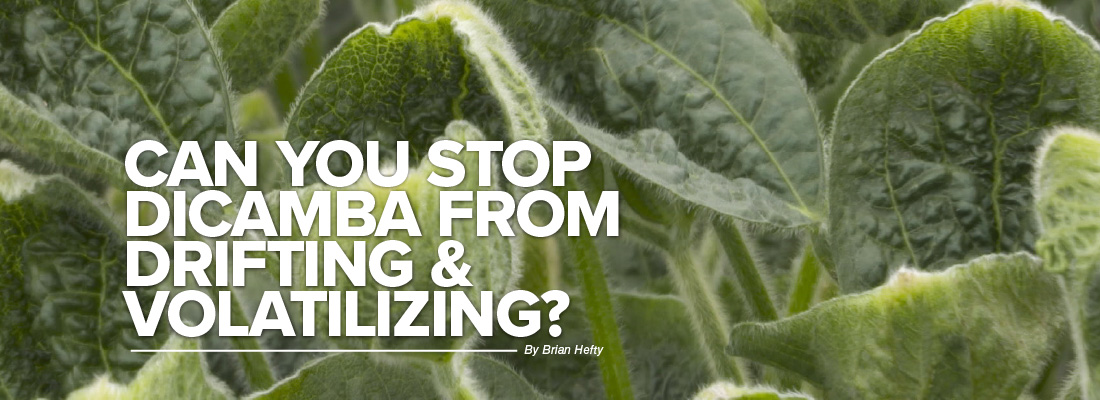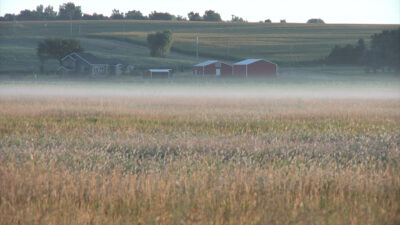
As you make your seed decisions for the coming year, you may find yourself asking one important question – can I prevent dicamba drift and volatilization? The short answer is no. However, you can reduce both drift and volatility enough so you won’t damage neighboring crops.
Here’s how.

Fog in a low-lying area is a sign of a temperature inversion. Temperature inversions are more common within two hours of sunrise and sunset, and they are a contributing factor to dicamba volatilization and off-target movement.
First of all, always use a labeled dicamba on a labeled crop at a labeled rate and time. Notice my emphasis on “labeled”. Unfortunately, we’ve seen far too much off-label use of dicamba in the past few years, to the point the EPA has strongly considered pulling it from the market entirely. We had a caller on Ag PhD Radio a couple months ago who twice mentioned using an off-label product on Xtend Soybeans. Please, if you want dicamba to be around three years from now, only use it as labeled.
Second, there are going to be many days and hours where you simply shouldn’t spray dicamba. Here’s my number one rule that unfortunately is not on the label. Always make sure the wind will be blowing away from a neighboring, sensitive crop for 48 hours after spraying. That way if there is any volatility, you have no real risk, since vapors coming off the plants are typically done in 24 to 48 hours.
Speaking of vapors, I just want to clarify what I mean by drift vs. volatility. Physical drift is when you are spraying and you see the spray move immediately with the wind to a sensitive crop. Volatility is when your spray hits your target, yet later turns to vapor, moving off the plant and up into the air.
Temperature inversions have been blamed for many of the volatility issues, although that is certainly not always the case. Normally, the air temperature is warmest at the soil surface and gets colder all the way up into the atmosphere. In the evening and early morning, it is common for temperatures to be warmer at 10, 20, or 50 feet in the air, with cool air above and below this warm zone. What can happen is vapors will move up to the warm air before going sideways. Avoiding inversions is easy. Just finish your spraying at least two hours before dusk, and start spraying at least two hours after dawn. Then 99% of the time, you will miss any inversions.
Going into 2021, look for a new spray adjuvant, VaporGrip Xtra, to be required when using dicamba. This will be in addition to other approved adjuvants, but the hope is that the use of proper adjuvants along with the right spray nozzles will curb both drift and volatility issues.
Another way we believe volatility issues are reduced is by spraying dicamba all by itself (other than the adjuvants). In other words, no Roundup, no volunteer corn herbicide, no fungicide, etc., just dicamba.
If you like to use dicamba in other crops, like corn, we encourage you to be careful there, as well. We saw tremendous amounts of leaf cupping in soybeans due to corn spraying. Granted, volatility issues typically lead to light leaf cupping in soybeans with no yield loss, but still, no one wants their soybeans cupped. With corn, spray early, and use the same rule I talked about earlier. If you’ve got a sensitive field right next to yours, just wait to spray until the forecast says the wind will blow away from the at-risk crop for 48 hours straight.
There are many other label requirements when spraying dicamba, including no use of ammonium sulfate, keeping your boom low, etc., so you may ask yourself – is it even worth it? That’s your call. Many farmers are skipping the use of dicamba, but dicamba is still very effective on many Roundup-resistant broadleaves including waterhemp, Palmer pigweed, kochia, marestail, and common ragweed. If you do choose to use dicamba this coming year, please use caution. If you pick the right day and time to spray and follow label directions, everything will be just fine.
CONTACT YOUR HEFTY AGRONOMIST FOR MORE INFORMATION.
